Papers by International Journal of Advances in Biology (IJAB)
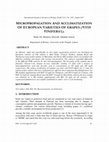
International Journal of Advances in Biology (IJAB), 2017
An efficient, rapid and reproducible in vitro plant regeneration protocol was developed for Europ... more An efficient, rapid and reproducible in vitro plant regeneration protocol was developed for European varieties of Vitis vinifera L. (Red Globe, Crimson Seedless, Autumn Royal and Thompson) using nodal explants on Murashige and Skoog (MS) medium which was fortified with different cytokinins and auxins with varying concentrations. The cultivars responded differently to the different PGRs used for In vitro micropropagation. The browning of the explants due to phenolics (Flavon-3-ols, tannins etc.)was reducedby washing 3-4 times with a mixture of antioxidants(Citric acid and Ascorbic acid in concentration of 150 mg/L and 100 mg/L respectively). The surface sterilization of explants was done with 0.01% HgCl 2 for 5-7 min. for getting aseptic cultures.The best combination for efficient shoot induction and multiplication was MS medium supplemented with BAP 2.0 mg/L for Thompson, with KN1.0 mg/L for Crimson, with BAP 4.0 mg/L for Autumn Royal and with BAP 1.0 mg/L for Red Globe, whereas the best rooting was obtained on ½ MS medium supplemented with IBA 2.0 mg/L for all varieties. The regenerated plantletswere successfully established in sand + soil (1:1) for hardening.
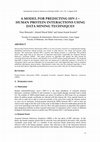
International Journal of Advances in Biology(IJAB), 2014
Discovering Protein-Protein Interactions (PPI) is an area of active research in computational bio... more Discovering Protein-Protein Interactions (PPI) is an area of active research in computational biology. Identifying interactions among proteins was shown to help discover new drugs and prevent many diseases. The interactions between HIV-1 proteins and Human proteins is a particular PPI problem which study might lead to the discovery of important interactions responsible for Acquired Immune Deficiency Syndrome (AIDS). This paper presents an algorithm that applies the data mining for extracting hierarchical bi-clusters and minimal covers of PPI without losing information. The proposed algorithm is based on the frequent closed item sets framework to efficiently generate a hierarchy of conceptual clusters and non-redundant sets of association rules with supporting object lists to integrate additional information about proteins. Experimental results show that the proposed algorithm is more accurate than Apriori Algorithm and predicted new interactions didn't discover by Tastan technique.
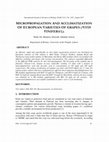
International Journal of Advances in Biology (IJAB), 2017
An efficient, rapid and reproducible in vitro plant regeneration protocol was developed for Europ... more An efficient, rapid and reproducible in vitro plant regeneration protocol was developed for European varieties of Vitis vinifera L. (Red Globe, Crimson Seedless, Autumn Royal and Thompson) using nodal explants on Murashige and Skoog (MS) medium which was fortified with different cytokinins and auxins with varying concentrations. The cultivars responded differently to the different PGRs used for In vitro micropropagation. The browning of the explants due to phenolics (Flavon-3-ols, tannins etc.)was reducedby washing 3-4 times with a mixture of antioxidants(Citric acid and Ascorbic acid in concentration of 150 mg/L and 100 mg/L respectively). The surface sterilization of explants was done with 0.01% HgCl 2 for 5-7 min. for getting aseptic cultures.The best combination for efficient shoot induction and multiplication was MS medium supplemented with BAP 2.0 mg/L for Thompson, with KN1.0 mg/L for Crimson, with BAP 4.0 mg/L for Autumn Royal and with BAP 1.0 mg/L for Red Globe, whereas the best rooting was obtained on ½ MS medium supplemented with IBA 2.0 mg/L for all varieties. The regenerated plantletswere successfully established in sand + soil (1:1) for hardening.
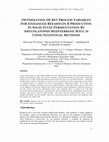
International Journal of Advances in Biology (IJAB), 2015
In the present study of solid media conditions for the refamycin B yield by solid state fermentat... more In the present study of solid media conditions for the refamycin B yield by solid state fermentation was studied and optimized using both classical method and statistical design of experiments). Statistical analysis of the results of Plackett–Burman showed that the lower level of initial moisture , initial pH, barbital, glucose and to solid media, or increase in the concentration of xylose in the range tested, results in significant effect in refamycin B yield of Amycolatopsis rifamycinica MTCC 14 by solid state fermentation. The effect of change in the levels of initial moisture, initial pH, barbital, glucose and xylose on the rfefamycin B yield was studied using central composite design methodology. Statistical analysis of the data showed that all the independent process had significant effect on refamycin B yield. The interaction between initial moisture and initial pH, between initial moisture and barbital, between initial moisture and glucose, between initial moisture and xylose, between initial pH and xylose, between barbital and glucose, between barbital and xylose, and between glucose and xylose were significant when the response was refamycin B.
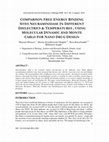
International Journal of Advances in Biology (IJAB), 2015
Neuraminidase (NA) is the essential surface glycoprotein of the influenza virus. High-affinity ne... more Neuraminidase (NA) is the essential surface glycoprotein of the influenza virus. High-affinity neuraminidase inhibitors have been designed that interact only with the conserved active site and binding site residues. The neuraminidase (NA) of influenza virus is the target of anti – flu drug.for treatment of this disease a thorough knowledge of neuraminidase protein is essential in order to produce potent drugs to suppress this enzyme..Drug design is by QSAR and docking methods, so we need a complete knowledge of receptor ligand, target site and binding site. This paper, using bioinformatics, Molecular Dynamics, Monte carlo and studied binding site NA enzyme in 310K temperature and different dielectrics (1, 78.39 and 32.63) for the best drug designing. We measured the potential energy of amino acids binding to the drug. Molecular Mechanics, Molecular Dynamic and Nanobiological have done a great assistance in drug designing.
International Journal of Advances in Biology (IJAB) , 2015
The aim of this paper is to detect exudates from the digital fundus images and provide informatio... more The aim of this paper is to detect exudates from the digital fundus images and provide information about Non Proliferative Diabetic Retinopathy. Diabetic retinopathy is very complicated disease that occurs when the retinal blood vessels changes. Exudates are the first sign of the diabetic retinopathy which cause blindness. So it is very important to find out these exudates in fundus image. In this paper we have proposed a method which is used for segmentation of optic disc and exudates. Morphological operations are used for detection of exudates. Before this operation we are applying Contrast Limited Adaptive Histogram Equalization technique. The results are compared with the standard database.
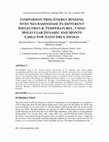
International Journal of Advances in Biology (IJAB), 2015
Neuraminidase (NA) is the essential surface glycoprotein of the influenza virus. High-affinity ne... more Neuraminidase (NA) is the essential surface glycoprotein of the influenza virus. High-affinity neuraminidase inhibitors have been designed that interact only with the conserved active site and binding site residues. The neuraminidase (NA) of influenza virus is the target of anti – flu drug.for treatment of this disease a thorough knowledge of neuraminidase protein is essential in order to produce potent drugs to suppress this enzyme..Drug design is by QSAR and docking methods, so we need a complete knowledge of receptor ligand, target site and binding site. This paper, using bioinformatics, Molecular Dynamics, Monte carlo and studied binding site NA enzyme in 310K temperature and different dielectrics (1, 78.39 and 32.63) for the best drug designing. We measured the potential energy of amino acids binding to the drug. Molecular Mechanics, Molecular Dynamic and Nanobiological have done a great assistance in drug designing.
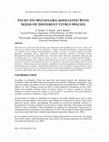
International Journal of Advances in Biology (IJAB) , 2015
This study was carried out on the mycoflora associated with seeds of different citrus species. Ci... more This study was carried out on the mycoflora associated with seeds of different citrus species. Citrus seed material was collected from districts of Punjab, i.e. Multan, Sargodha and Khanpur. Standard methods were applied for the isolation and identification of fungi. A total of 11 fungi including Aspergillus fumigatus, Aspergillus flavus, Dreschslera tetramera, Alternaria alternata, Curvularia lunata, Macrophomina phaseolina, Aspergillus niger, Fusarium solani, Fusarium moniliforme, Rhizopus and Penicillium spp were isolated from the seeds of citrus. For control of isolated seed-born fungi, 3 recommended fungicides such as Ridomil Gold, Bavistin, Score and two chemical Salicylic acid and Boric acid, were used at 20, 30, 40 mg/10 mL and 5, 6, 7 µL/10 mL, respectively and chemical with 20, 30, 40 mg/10 mL. All these fungicide and chemicals significantly reuced with population of all fungi present in naturally infected seed samples. Ridomil Gold and Salicylic acid were found to be the best for the control of seed-born fungi of citrus seed at 40 mg/10 mL. The isolation and identification of different mycotoxins is essential to study health status of the citrus consumers and to safeguard the standards of WTO.
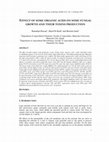
International Journal of Advances in Biology (IJAB), 2015
The effect of eight organic acids (propionic, acetic, formic, lactic, tartaric, citric, oxalic an... more The effect of eight organic acids (propionic, acetic, formic, lactic, tartaric, citric, oxalic and malic acids) as antifungal agents on the growth of four fungi (Aspergillus flavus, Penicillium purpurogenum, Rhizopus nigricans and Fusarium oxysporum) were studied. The high acidity appeared for oxalic acid being 0.14 at the high concentration (10%), while the lowest acidity recorded for propionic acid and acetic acid being 2.71 and 2.56 at the low concentration (5%). It was observed that, there was no relationship between the efficacy of organic acid and its final pH. Acetic acid (10%) has the highest inhibitory effect on A. flavus being 45.21%, but tartaric acid (5%) and citric acid (5%) gave the same lowest inhibition effect (0.42%). The lowest value of mycelium dry weight (MDW) of P. purpurogenum was 5.92 g/l when acetic acid was used (10%), but the highest value was 9.38 g/l when tartaric acid (5%) was used. Formic acid (10%) had a strong effect on the inhibition growth of R. nigricans being 28.65%, similar to propionic acid (10%), acetic acid (10%), lactic acid (10%), tartaric acid (10%) and citric acid (10%) being 26.57%, 26.38%, 26.19%, 23.53% and 24.48%, respectively. But malic acid (5%) and oxalic acid (5%) were having a week effect on R. nigricans being 5.31% and 6.45%, respectively. Lactic acid (10%) has the highest inhibitory effect on F. oxysporum being 34.45% and the lowest value was in the case of tartaric acid (5%) being 1.68%. Four treatments were used to determine aflatoxin B 1 production. The highest inhibition (50%) was observed by R. nigricans in the presence of formic acid (10%). Acetic acid in 10% level inhibited the toxic secretion of A. flavus and P. purpurogenum to become 25% and 40%, respectively. Lactic acid (10%) gave 35% inhibition of toxin production in the presence of F. oxysporum.
There have been many researches about aging. Our study suggests a new research method using RTEL ... more There have been many researches about aging. Our study suggests a new research method using RTEL (Regulator of Telomere Elongation Helicase). Telomere is the very-end part of chromatid to preserve the terminal information which can be lost during DNA replication. We have compared the RTEL DNA sequence among mammals whose lifespan is all different so that we can see how RTEL DNA sequence influence lifespan and aging. Also, all of these studies were proved by apriori and decision tree. Furthermore, we can continue this experiment to Cancer. In fact, telomere is under the spotlight for the clue of cancer because a cancer cell has telomerase so that it can divide for limitlessly. So, our results could be used as background knowledge for the research of Cancer by specifying the relations between telomere and aging in mammals.
International Journal of Advances in Biology (IJAB) , 2015
The aim of this paper is to detect exudates from the digital fundus images and provide informatio... more The aim of this paper is to detect exudates from the digital fundus images and provide information about Non Proliferative Diabetic Retinopathy. Diabetic retinopathy is very complicated disease that occurs when the retinal blood vessels changes. Exudates are the first sign of the diabetic retinopathy which cause blindness. So it is very important to find out these exudates in fundus image. In this paper we have proposed a method which is used for segmentation of optic disc and exudates. Morphological operations are used for detection of exudates. Before this operation we are applying Contrast Limited Adaptive Histogram Equalization technique. The results are compared with the standard database.
The aim of this paper is to detect exudates from the digital fundus images and provide informatio... more The aim of this paper is to detect exudates from the digital fundus images and provide information about
Non Proliferative Diabetic Retinopathy. Diabetic retinopathy is very complicated disease that occur
s
when the retinal blood vessels changes. Exudates are the first sign of the diabetic retinopathy which cause
blindness. So it is very important to find out these exudates in fundus image. In this paper we have
proposed a method which is used for segmentat
ion of optic disc and exudates. Morphological operations
are used for detection of exudates. Before this operation we are applying Contrast Limited Adaptive
Histogram Equalization technique. The results are compared with the standard database.
Potato, (Solanum tuberosum L,) have various biotic constraints in its production due to pest atta... more Potato, (Solanum tuberosum L,) have various biotic constraints in its production due to pest attack. Among
these, common scab caused by streptomyces scabies in an important disease in potato which causes
economic loss with respect to plant yield and quality of tubers. The present study was conducted to
determine the pathogenicity, pathogenic variation, characterization of morphological, physiological and
biochemical aspects of Streptomyces specie associated with potato tubers grown in Rawalpindi district.
Severity data and pathogenic variation of disease was studied by using different isolation and
characterization techniques. Isolation and characterization of Streptomyces spp. From potato tubers will
guide the researchers about the causative strains of common scab of potato present in the particular area.
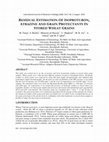
This study was carried out to see the occurrence and level of pesticide residues in stored wheat ... more This study was carried out to see the occurrence and level of pesticide residues in stored wheat grain
samples. Wheat grains were collected from different godowns located in Faisalabad district. Weedicide
residues in wheat grains were analyzed by using thin plate liquid chromatography and validated high
performance liquid chromatography. On the basis of extent of inhibition of the Hill reaction, it was found
that the level of atrazine was (0-0.028 ngkg-1) and the level of isopproturon was (0-0.024 ngkg-1) in test
samples. The calculated values were below the Maximum Residue Limit (MEL) i.e. 100 ngkg-1 for atrazine
and 2200 ngkg-1 for isoproturon. It was found that presence of herbicide residues in stored wheat was
negligible. Further, on wheat grain samples placed in jars and treated with deltamethrin and cypermethrin
@0.4 and 0.8% concentration. The persistency data was calculated after 1 hour, 7, 15 and 30 days of
treatment. The grain protectants were continuously degraded with the passage of time and after the 30 days
the amount of residues of the grain protectants was found to be very small. It was concluded that the use of
the grain protectants in the powder form in combination with other botanicals on stored wheat samples is
feasible to reduce the insect pest in stored grains.
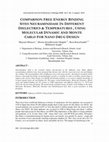
Neuraminidase (NA) is the essential surface glycoprotein of the influenza virus. High- affinity
n... more Neuraminidase (NA) is the essential surface glycoprotein of the influenza virus. High- affinity
neuraminidase inhibitors have been designed that interact only with the conserved active site and binding
site residues. The neuraminidase (NA) of influenza virus is the target of anti – flu drug.for treatment of this
disease a thorough knowledge of neuraminidase protein is essential in order to produce potent drugs to
suppress this enzyme..Drug design is by QSAR and docking methods, so we need a complete knowledge of
receptor ligand, target site and binding site. This paper, using bioinformatics, Molecular Dynamics, Monte
carlo and studied binding site NA enzyme in 310K temperature and different dielectrics (1, 78.39 and
32.63) for the best drug designing. We measured the potential energy of amino acids binding to the drug.
Molecular Mechanics, Molecular Dynamic and Nanobiological have done a great assistance in drug
designing.
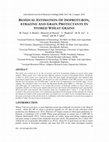
This study was carried out to see the occurrence and level of pesticide residues in stored wheat ... more This study was carried out to see the occurrence and level of pesticide residues in stored wheat grain
samples. Wheat grains were collected from different godowns located in Faisalabad district. Weedicide
residues in wheat grains were analyzed by using thin plate liquid chromatography and validated high
performance liquid chromatography. On the basis of extent of inhibition of the Hill reaction, it was found
that the level of atrazine was (0-0.028 ngkg-1) and the level of isopproturon was (0-0.024 ngkg-1) in test
samples. The calculated values were below the Maximum Residue Limit (MEL) i.e. 100 ngkg-1 for atrazine
and 2200 ngkg-1 for isoproturon. It was found that presence of herbicide residues in stored wheat was
negligible. Further, on wheat grain samples placed in jars and treated with deltamethrin and cypermethrin
@0.4 and 0.8% concentration. The persistency data was calculated after 1 hour, 7, 15 and 30 days of
treatment. The grain protectants were continuously degraded with the passage of time and after the 30 days
the amount of residues of the grain protectants was found to be very small. It was concluded that the use of
the grain protectants in the powder form in combination with other botanicals on stored wheat samples is
feasible to reduce the insect pest in stored grains
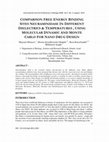
Neuraminidase (NA) is the essential surface glycoprotein of the influenza virus. High- affinity n... more Neuraminidase (NA) is the essential surface glycoprotein of the influenza virus. High- affinity neuraminidase inhibitors have been designed that interact only with the conserved active site and binding site residues. The neuraminidase (NA) of influenza virus is the target of anti – flu drug.for treatment of this disease a thorough knowledge of neuraminidase protein is essential in order to produce potent drugs to suppress this enzyme..Drug design is by QSAR and docking methods, so we need a complete knowledge of receptor ligand, target site and binding site. This paper, using bioinformatics, Molecular Dynamics, Monte carlo and studied binding site NA enzyme in 310K temperature and different dielectrics (1, 78.39 and 32.63) for the best drug designing. We measured the potential energy of amino acids binding to the drug. Molecular Mechanics, Molecular Dynamic and Nanobiological have done a great assistance in drug designing.

In the present study of solid media conditions for the refamycin B yield by solid state fermentat... more In the present study of solid media conditions for the refamycin B yield by solid state fermentation was
studied and optimized using both classical method and statistical design of experiments). Statistical
analysis of the results of Plackett–Burman showed that the lower level of initial moisture , initial pH,
barbital, glucose and to solid media, or increase in the concentration of xylose in the range tested, results
in significant effect in refamycin B yield of Amycolatopsis rifamycinica MTCC 14 by solid state
fermentation. The effect of change in the levels of initial moisture, initial pH, barbital, glucose and xylose
on the rfefamycin B yield was studied using central composite design methodology. Statistical analysis of
the data showed that all the independent process had significant effect on refamycin B yield. The
interaction between initial moisture and initial pH, between initial moisture and barbital, between initial
moisture and glucose, between initial moisture and xylose, between initial pH and xylose, between
barbital and glucose, between barbital and xylose, and between glucose and xylose were significant when
the response was refamycin B.
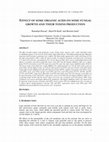
The effect of eight organic acids (propionic, acetic, formic, lactic, tartaric, citric, oxalic an... more The effect of eight organic acids (propionic, acetic, formic, lactic, tartaric, citric, oxalic and malic acids)
as antifungal agents on the growth of four fungi (Aspergillus flavus, Penicillium purpurogenum, Rhizopus
nigricans and Fusarium oxysporum) were studied. The high acidity appeared for oxalic acid being 0.14 at
the high concentration (10%), while the lowest acidity recorded for propionic acid and acetic acid being
2.71 and 2.56 at the low concentration (5%). It was observed that, there was no relationship between the
efficacy of organic acid and its final pH. Acetic acid (10%) has the highest inhibitory effect on A. flavus
being 45.21%, but tartaric acid (5%) and citric acid (5%) gave the same lowest inhibition effect (0.42%).
The lowest value of mycelium dry weight (MDW) of P. purpurogenum was 5.92 g/l when acetic acid was
used (10%), but the highest value was 9.38 g/l when tartaric acid (5%) was used. Formic acid (10%) had a
strong effect on the inhibition growth of R. nigricans being 28.65%, similar to propionic acid (10%), acetic
acid (10%), lactic acid (10%), tartaric acid (10%) and citric acid (10%) being 26.57%, 26.38%, 26.19%,
23.53% and 24.48%, respectively. But malic acid (5%) and oxalic acid (5%) were having a week effect on
R. nigricans being 5.31% and 6.45%, respectively. Lactic acid (10%) has the highest inhibitory effect on F.
oxysporum being 34.45% and the lowest value was in the case of tartaric acid (5%) being 1.68%. Four
treatments were used to determine aflatoxin B1 production. The highest inhibition (50%) was observed by
R. nigricans in the presence of formic acid (10%). Acetic acid in 10% level inhibited the toxic secretion of
A. flavus and P. purpurogenum to become 25% and 40%, respectively. Lactic acid (10%) gave 35%
inhibition of toxin production in the presence of F. oxysporum.





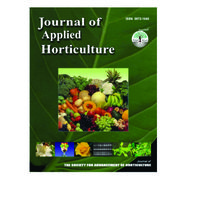




Uploads
Papers by International Journal of Advances in Biology (IJAB)
Non Proliferative Diabetic Retinopathy. Diabetic retinopathy is very complicated disease that occur
s
when the retinal blood vessels changes. Exudates are the first sign of the diabetic retinopathy which cause
blindness. So it is very important to find out these exudates in fundus image. In this paper we have
proposed a method which is used for segmentat
ion of optic disc and exudates. Morphological operations
are used for detection of exudates. Before this operation we are applying Contrast Limited Adaptive
Histogram Equalization technique. The results are compared with the standard database.
these, common scab caused by streptomyces scabies in an important disease in potato which causes
economic loss with respect to plant yield and quality of tubers. The present study was conducted to
determine the pathogenicity, pathogenic variation, characterization of morphological, physiological and
biochemical aspects of Streptomyces specie associated with potato tubers grown in Rawalpindi district.
Severity data and pathogenic variation of disease was studied by using different isolation and
characterization techniques. Isolation and characterization of Streptomyces spp. From potato tubers will
guide the researchers about the causative strains of common scab of potato present in the particular area.
samples. Wheat grains were collected from different godowns located in Faisalabad district. Weedicide
residues in wheat grains were analyzed by using thin plate liquid chromatography and validated high
performance liquid chromatography. On the basis of extent of inhibition of the Hill reaction, it was found
that the level of atrazine was (0-0.028 ngkg-1) and the level of isopproturon was (0-0.024 ngkg-1) in test
samples. The calculated values were below the Maximum Residue Limit (MEL) i.e. 100 ngkg-1 for atrazine
and 2200 ngkg-1 for isoproturon. It was found that presence of herbicide residues in stored wheat was
negligible. Further, on wheat grain samples placed in jars and treated with deltamethrin and cypermethrin
@0.4 and 0.8% concentration. The persistency data was calculated after 1 hour, 7, 15 and 30 days of
treatment. The grain protectants were continuously degraded with the passage of time and after the 30 days
the amount of residues of the grain protectants was found to be very small. It was concluded that the use of
the grain protectants in the powder form in combination with other botanicals on stored wheat samples is
feasible to reduce the insect pest in stored grains.
neuraminidase inhibitors have been designed that interact only with the conserved active site and binding
site residues. The neuraminidase (NA) of influenza virus is the target of anti – flu drug.for treatment of this
disease a thorough knowledge of neuraminidase protein is essential in order to produce potent drugs to
suppress this enzyme..Drug design is by QSAR and docking methods, so we need a complete knowledge of
receptor ligand, target site and binding site. This paper, using bioinformatics, Molecular Dynamics, Monte
carlo and studied binding site NA enzyme in 310K temperature and different dielectrics (1, 78.39 and
32.63) for the best drug designing. We measured the potential energy of amino acids binding to the drug.
Molecular Mechanics, Molecular Dynamic and Nanobiological have done a great assistance in drug
designing.
samples. Wheat grains were collected from different godowns located in Faisalabad district. Weedicide
residues in wheat grains were analyzed by using thin plate liquid chromatography and validated high
performance liquid chromatography. On the basis of extent of inhibition of the Hill reaction, it was found
that the level of atrazine was (0-0.028 ngkg-1) and the level of isopproturon was (0-0.024 ngkg-1) in test
samples. The calculated values were below the Maximum Residue Limit (MEL) i.e. 100 ngkg-1 for atrazine
and 2200 ngkg-1 for isoproturon. It was found that presence of herbicide residues in stored wheat was
negligible. Further, on wheat grain samples placed in jars and treated with deltamethrin and cypermethrin
@0.4 and 0.8% concentration. The persistency data was calculated after 1 hour, 7, 15 and 30 days of
treatment. The grain protectants were continuously degraded with the passage of time and after the 30 days
the amount of residues of the grain protectants was found to be very small. It was concluded that the use of
the grain protectants in the powder form in combination with other botanicals on stored wheat samples is
feasible to reduce the insect pest in stored grains
studied and optimized using both classical method and statistical design of experiments). Statistical
analysis of the results of Plackett–Burman showed that the lower level of initial moisture , initial pH,
barbital, glucose and to solid media, or increase in the concentration of xylose in the range tested, results
in significant effect in refamycin B yield of Amycolatopsis rifamycinica MTCC 14 by solid state
fermentation. The effect of change in the levels of initial moisture, initial pH, barbital, glucose and xylose
on the rfefamycin B yield was studied using central composite design methodology. Statistical analysis of
the data showed that all the independent process had significant effect on refamycin B yield. The
interaction between initial moisture and initial pH, between initial moisture and barbital, between initial
moisture and glucose, between initial moisture and xylose, between initial pH and xylose, between
barbital and glucose, between barbital and xylose, and between glucose and xylose were significant when
the response was refamycin B.
as antifungal agents on the growth of four fungi (Aspergillus flavus, Penicillium purpurogenum, Rhizopus
nigricans and Fusarium oxysporum) were studied. The high acidity appeared for oxalic acid being 0.14 at
the high concentration (10%), while the lowest acidity recorded for propionic acid and acetic acid being
2.71 and 2.56 at the low concentration (5%). It was observed that, there was no relationship between the
efficacy of organic acid and its final pH. Acetic acid (10%) has the highest inhibitory effect on A. flavus
being 45.21%, but tartaric acid (5%) and citric acid (5%) gave the same lowest inhibition effect (0.42%).
The lowest value of mycelium dry weight (MDW) of P. purpurogenum was 5.92 g/l when acetic acid was
used (10%), but the highest value was 9.38 g/l when tartaric acid (5%) was used. Formic acid (10%) had a
strong effect on the inhibition growth of R. nigricans being 28.65%, similar to propionic acid (10%), acetic
acid (10%), lactic acid (10%), tartaric acid (10%) and citric acid (10%) being 26.57%, 26.38%, 26.19%,
23.53% and 24.48%, respectively. But malic acid (5%) and oxalic acid (5%) were having a week effect on
R. nigricans being 5.31% and 6.45%, respectively. Lactic acid (10%) has the highest inhibitory effect on F.
oxysporum being 34.45% and the lowest value was in the case of tartaric acid (5%) being 1.68%. Four
treatments were used to determine aflatoxin B1 production. The highest inhibition (50%) was observed by
R. nigricans in the presence of formic acid (10%). Acetic acid in 10% level inhibited the toxic secretion of
A. flavus and P. purpurogenum to become 25% and 40%, respectively. Lactic acid (10%) gave 35%
inhibition of toxin production in the presence of F. oxysporum.
Non Proliferative Diabetic Retinopathy. Diabetic retinopathy is very complicated disease that occur
s
when the retinal blood vessels changes. Exudates are the first sign of the diabetic retinopathy which cause
blindness. So it is very important to find out these exudates in fundus image. In this paper we have
proposed a method which is used for segmentat
ion of optic disc and exudates. Morphological operations
are used for detection of exudates. Before this operation we are applying Contrast Limited Adaptive
Histogram Equalization technique. The results are compared with the standard database.
these, common scab caused by streptomyces scabies in an important disease in potato which causes
economic loss with respect to plant yield and quality of tubers. The present study was conducted to
determine the pathogenicity, pathogenic variation, characterization of morphological, physiological and
biochemical aspects of Streptomyces specie associated with potato tubers grown in Rawalpindi district.
Severity data and pathogenic variation of disease was studied by using different isolation and
characterization techniques. Isolation and characterization of Streptomyces spp. From potato tubers will
guide the researchers about the causative strains of common scab of potato present in the particular area.
samples. Wheat grains were collected from different godowns located in Faisalabad district. Weedicide
residues in wheat grains were analyzed by using thin plate liquid chromatography and validated high
performance liquid chromatography. On the basis of extent of inhibition of the Hill reaction, it was found
that the level of atrazine was (0-0.028 ngkg-1) and the level of isopproturon was (0-0.024 ngkg-1) in test
samples. The calculated values were below the Maximum Residue Limit (MEL) i.e. 100 ngkg-1 for atrazine
and 2200 ngkg-1 for isoproturon. It was found that presence of herbicide residues in stored wheat was
negligible. Further, on wheat grain samples placed in jars and treated with deltamethrin and cypermethrin
@0.4 and 0.8% concentration. The persistency data was calculated after 1 hour, 7, 15 and 30 days of
treatment. The grain protectants were continuously degraded with the passage of time and after the 30 days
the amount of residues of the grain protectants was found to be very small. It was concluded that the use of
the grain protectants in the powder form in combination with other botanicals on stored wheat samples is
feasible to reduce the insect pest in stored grains.
neuraminidase inhibitors have been designed that interact only with the conserved active site and binding
site residues. The neuraminidase (NA) of influenza virus is the target of anti – flu drug.for treatment of this
disease a thorough knowledge of neuraminidase protein is essential in order to produce potent drugs to
suppress this enzyme..Drug design is by QSAR and docking methods, so we need a complete knowledge of
receptor ligand, target site and binding site. This paper, using bioinformatics, Molecular Dynamics, Monte
carlo and studied binding site NA enzyme in 310K temperature and different dielectrics (1, 78.39 and
32.63) for the best drug designing. We measured the potential energy of amino acids binding to the drug.
Molecular Mechanics, Molecular Dynamic and Nanobiological have done a great assistance in drug
designing.
samples. Wheat grains were collected from different godowns located in Faisalabad district. Weedicide
residues in wheat grains were analyzed by using thin plate liquid chromatography and validated high
performance liquid chromatography. On the basis of extent of inhibition of the Hill reaction, it was found
that the level of atrazine was (0-0.028 ngkg-1) and the level of isopproturon was (0-0.024 ngkg-1) in test
samples. The calculated values were below the Maximum Residue Limit (MEL) i.e. 100 ngkg-1 for atrazine
and 2200 ngkg-1 for isoproturon. It was found that presence of herbicide residues in stored wheat was
negligible. Further, on wheat grain samples placed in jars and treated with deltamethrin and cypermethrin
@0.4 and 0.8% concentration. The persistency data was calculated after 1 hour, 7, 15 and 30 days of
treatment. The grain protectants were continuously degraded with the passage of time and after the 30 days
the amount of residues of the grain protectants was found to be very small. It was concluded that the use of
the grain protectants in the powder form in combination with other botanicals on stored wheat samples is
feasible to reduce the insect pest in stored grains
studied and optimized using both classical method and statistical design of experiments). Statistical
analysis of the results of Plackett–Burman showed that the lower level of initial moisture , initial pH,
barbital, glucose and to solid media, or increase in the concentration of xylose in the range tested, results
in significant effect in refamycin B yield of Amycolatopsis rifamycinica MTCC 14 by solid state
fermentation. The effect of change in the levels of initial moisture, initial pH, barbital, glucose and xylose
on the rfefamycin B yield was studied using central composite design methodology. Statistical analysis of
the data showed that all the independent process had significant effect on refamycin B yield. The
interaction between initial moisture and initial pH, between initial moisture and barbital, between initial
moisture and glucose, between initial moisture and xylose, between initial pH and xylose, between
barbital and glucose, between barbital and xylose, and between glucose and xylose were significant when
the response was refamycin B.
as antifungal agents on the growth of four fungi (Aspergillus flavus, Penicillium purpurogenum, Rhizopus
nigricans and Fusarium oxysporum) were studied. The high acidity appeared for oxalic acid being 0.14 at
the high concentration (10%), while the lowest acidity recorded for propionic acid and acetic acid being
2.71 and 2.56 at the low concentration (5%). It was observed that, there was no relationship between the
efficacy of organic acid and its final pH. Acetic acid (10%) has the highest inhibitory effect on A. flavus
being 45.21%, but tartaric acid (5%) and citric acid (5%) gave the same lowest inhibition effect (0.42%).
The lowest value of mycelium dry weight (MDW) of P. purpurogenum was 5.92 g/l when acetic acid was
used (10%), but the highest value was 9.38 g/l when tartaric acid (5%) was used. Formic acid (10%) had a
strong effect on the inhibition growth of R. nigricans being 28.65%, similar to propionic acid (10%), acetic
acid (10%), lactic acid (10%), tartaric acid (10%) and citric acid (10%) being 26.57%, 26.38%, 26.19%,
23.53% and 24.48%, respectively. But malic acid (5%) and oxalic acid (5%) were having a week effect on
R. nigricans being 5.31% and 6.45%, respectively. Lactic acid (10%) has the highest inhibitory effect on F.
oxysporum being 34.45% and the lowest value was in the case of tartaric acid (5%) being 1.68%. Four
treatments were used to determine aflatoxin B1 production. The highest inhibition (50%) was observed by
R. nigricans in the presence of formic acid (10%). Acetic acid in 10% level inhibited the toxic secretion of
A. flavus and P. purpurogenum to become 25% and 40%, respectively. Lactic acid (10%) gave 35%
inhibition of toxin production in the presence of F. oxysporum.